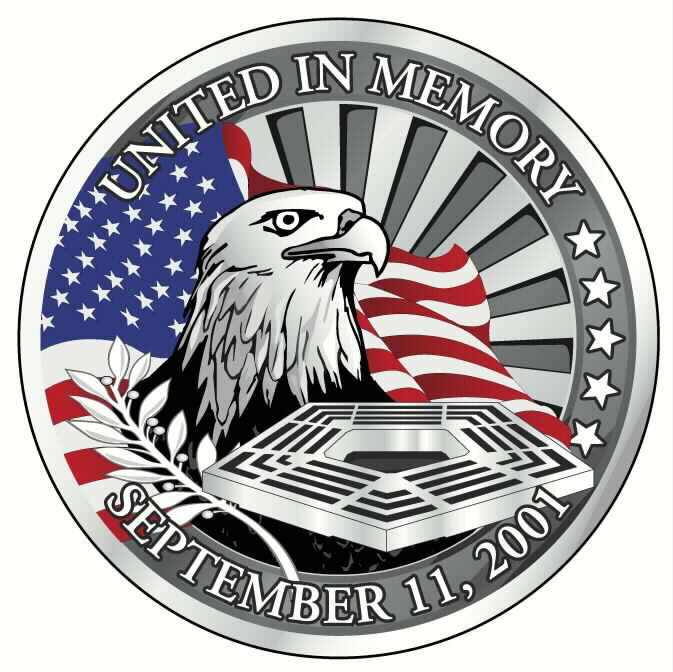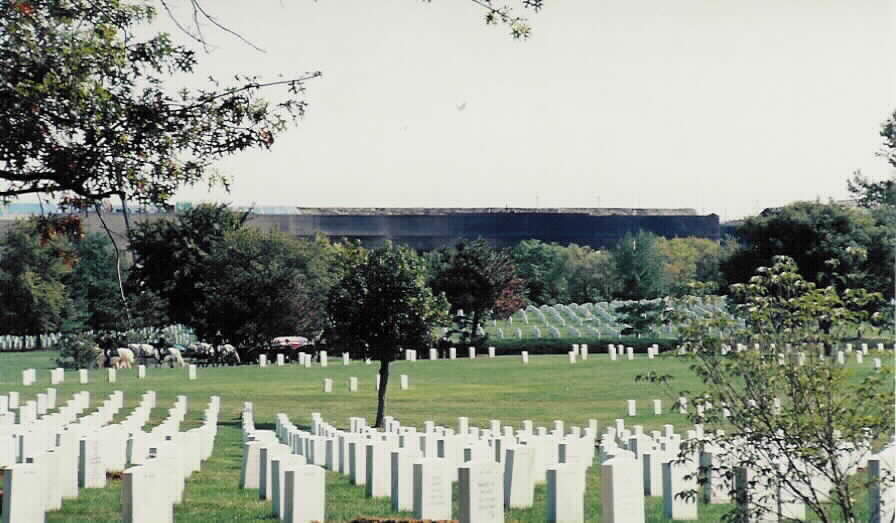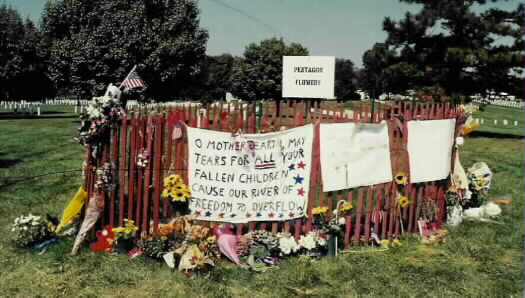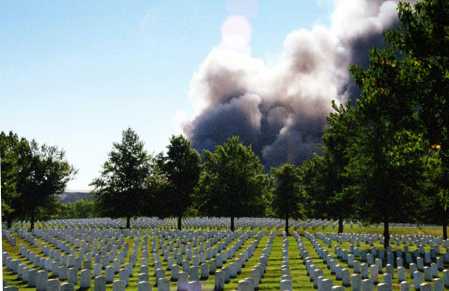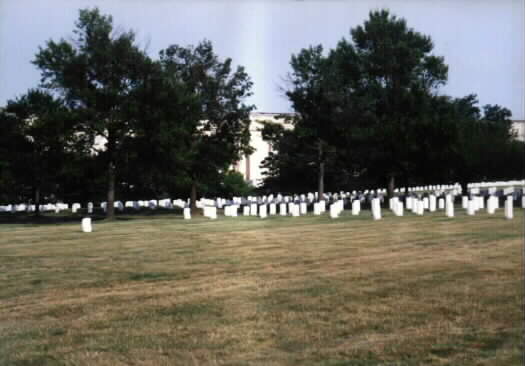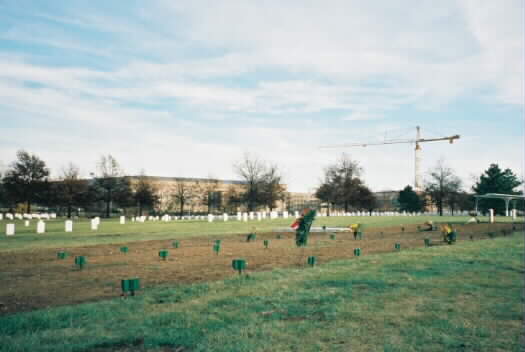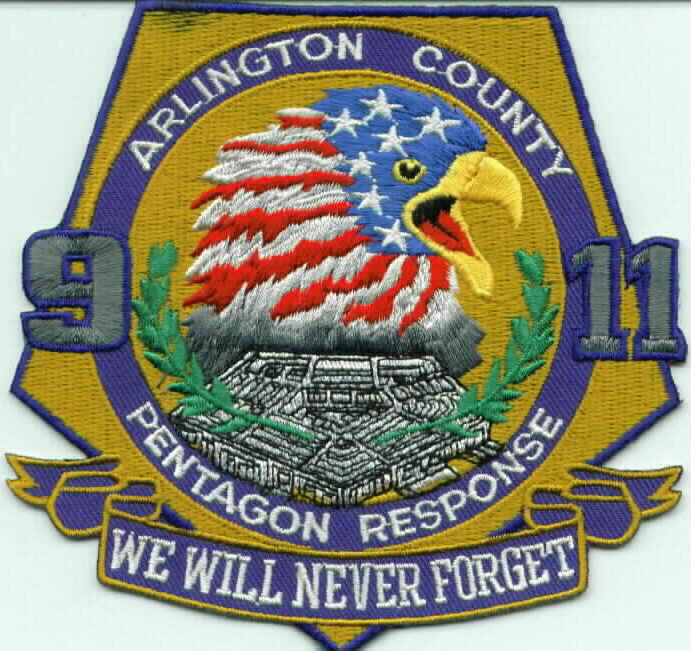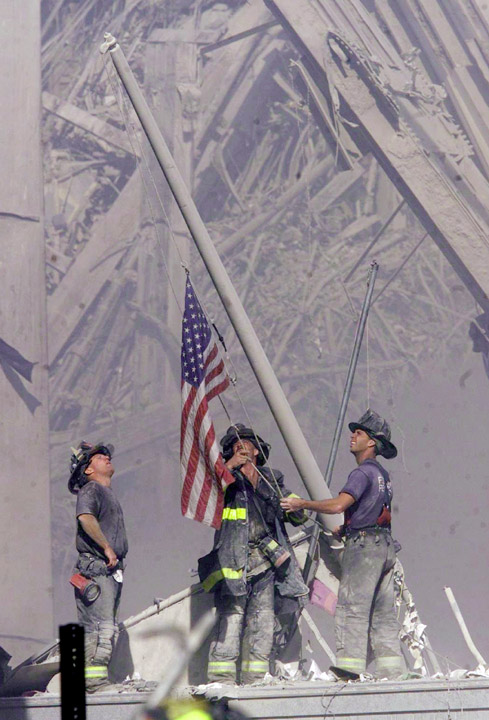The following victims of the terror attack on the Pentagon
on 11 September 2001have been laid to rest in
Arlington National Cemetery
A Funeral caisson near the still-smoldering Pentagon, Arlington National Cemetery
A memorial in Section 64 of Arlington National Cemetery where many of the victims of the attack on the Pentagon are being laid to rest.
Smoke Drifts From The Pentagon Toward Arlington National Cemetery
11 September 2001
The Pentagon From Section 64 Of Arlington National Cemetery.
Many of the Military victims of the terrorist attack are at rest in Section 64.
Victims of the Terrorist Attack on The Pentagon
11 September 2001
Craig Scott Amundson, Specialist, United States Army
Max Bielke, Master Sergeant, United States Army
Kris Romeo Bishundat, Systems Technician, United States Navy
Mary Jane Booth, United States Army Spouse & September 11 Victim
Jose Orlando Calderon, Sr., Sergeant, United States Army
Canfield D. Boone, Colonel, United States Army
Charles Frank Burlingame III, Captain, United States Navy – American Air Lines Flight 77 Pilot
Angelene C. Carter, Army Spouse & Government Employee
John J. Chada, Sergeant, United States Army
Rosemary Chapa, Military Spouse & Government Employee
Julian T. Cooper, Contractor, United States Navy
Eric Allen Cranford, Commander, United States Navy
Ada Davis, Department of the Army
Gerald G. DeConto, Captain, United States Navy
Charles Droz, Lieutenant Commander, United States Navy & Company President
Patrick Dunn, Commander, United States Navy
Robert Randolph Elseth, Lieutenant Commander, United States Navy
Dana Falkenberg, Civilian Child – Unidentified
Amelia Virginia Fields, Military Spouse & Government Employee
Sandra Hill Foster, Army Spouse And Government Employee
Richard Peter Gabriel, Sr., First Lieuetnant, United States Marine Corps
Lawrence D. Getzfred, Captain, United States Navy
Ronald Golinski, Colonel, United States Army – Unidentified
Carolyn Halmon, Military Spouse & Government Employee
Ronald J. Hemenway, United States Navy – Unidentified
Wallace Cole Hogan, Jr., Major, United States Army
Jimmie Ira Holley, Sergeant, United States Army (Retired) Government Employee
Stephen Neil Hyland, Jr., Lieutenant Colonel, United States Army
Robert Joseph Hymel, Lieutenant Colonel, United States Air Force
Lacey B. Ivory, Sergeant Major, United States Army
Dennis M. Johnson, Lieutenant Colonel, United States Army
Michael Scott Lamana, Lieutenant, United States Navy
Stephen Vernon Long, Major, United States Army
James T. Lynch, Navy Employee – Unidentified
Dean E. Mattson, Lieutenant Colonel, United States Army
Timothy J. Maude, Lieutenant General, United States Army
Patricia E. Mickley, Government Employee
Ronald D. Milam, Major, United States Army
Gerald P. Moran, United States Navy (Ret) & Government Employee
Brian Anthony Moss, Petty Officer Second Class, United States Navy
Patrick Jude Murphy, Lieutenant Commander, United States Navy
Clifford Patterson, Jr., Major, United States Army
Deborah A. Ramsaur, Military Spouse & Government Employee
Rhonda Ridge Rasmussen, Department of the Army Employee – Unidentified
Robert Erroll Russell, Sr., Sergeant Major, United States Army
Charles E. Sabin, Captain, United States Army – Government Employee
Marjorie Champion Salamone, Army Spouse & Government Employee
David Scales, Lieutenant Colonel, United States Army
Robert Allan Schlegel, Commander, United States Navy
Janice Marie Scott, Army Spouse & Government Employee
Michael L. Selves, Lieutenant Colonel, United States Army
Dan F. Shanower, Commander, United States Navy
Gregg Harold Smallwood, Chief Information Systems Technician, United States Navy
Gary F. Smith, Lieutenant Colonel, United States Army
Mari-Rae Sopper, Lieutenant (Retired), United States Navy – Aboard Flight 77
Larry L. Strickland,Sergeant Major, United States Army
Kip Paul Taylor, Lieutenant Colonel, United States Army
Karl W. Teepe, United States Army Retired & Government Employee
Otis Vincent Tolbert, Lieuenant Commander, United States Navy
Ronald James Vauk, Lieutenant Commander, United States Navy
Meta Fuller Waller, Military Widow & Government Employee
Chin Sun Pak Wells, Specialist, United States Army
Maudlyn White, Sergeant, United States Army
Sandra White, Army Spouse & Government Employee
David L. Williams, Lieutenant Commander, United States Navy
Dwayne Williams, Major, United States Army
Marvin Roger Woods, Chief, United States Navy
John D. Yamnicky, Sr., Captain, United States Navy – Aboard American Flight 77
Donald McArthur Young, ITC, United States Navy
Terrorist Attack On The Pentagon: 11 September 2001
Unidentified Pentagon Victims Laid To Rest At Arlington National Cemetery
Pentagon Memorial Service At Arlington National Cemetery (Photos)
Photos of the Memorial Service By Katrina Garland
Remembering The Pentagon Victims: 11 September 2004
Friday, August 16, 2002
Government to Bury Unidentifiable Remains
Unidentifiable remains of victims of the September 11, 2001, attack on the Pentagon will be buried in Arlington National Cemetery, the military said Friday.
The September 12, 2002, ceremony will hold special significance for families of five people whose remains have never been identified, said Colonel Jody Draves, a spokeswoman for the Military District of Washington, which oversees the cemetery.
The service will include burial of the cremated ashes of all remains not linked to a particular victim, as well as some remains which were identified that family members asked to be included.
“The intent is not as a memorial service but as a group burial for victims not identified,” Draves said.
The Pentagon attack killed 189 people: 125 in the Pentagon and 64 aboard American Airlines Flight 77. Remains of the five hijackers on the flight have been separated from those of the victims.
The five victims whose remains have not been identified include:
Retired Army Colonel Ronald Golinski, a civilian Pentagon worker
Navy ET1 Ronald Henanway
Rhonda Rasmussen, a civilian worker for the Army
Jack T. Lynch, a civilian worker for the Navy
Dana Falkenberg, a passenger on Flight 77
About the photo
September 11, 2001 — the end of the world as we knew it. But in the chaos and rubble where the World Trade Center no longer stood, Record photographer Thomas E. Franklin captured an unforgettable image of hope — three firefighters raising the American flag.
Standing defiantly against the gray and white landscape of devastation, these dust-covered men and the vivid red, white, and blue of Old Glory instantly became a symbol of American patriotism. Franklin’s photo of these three heroic rescuers — Brooklyn-based firefighters Dan McWilliams of Long Island, George Johnson of Rockaway Beach (both from Ladder 157), and Billy Eisengrein of Staten Island (Rescue 2) — also became a global message that life, and America, would go on.
The photo, which appeared September 12 in The Record, has since graced the pages of many other newspapers as well as national newsmagazines. Network television has repeatedly displayed the photo during its round-the-clock disaster coverage, comparing it to the famous image of Marines raising the flag on Iwo Jima during World War II.
Franklin, an eight-year veteran of The Record, took the photo late in the afternoon of Sept. 11, after spending hours at the scene. He was walking toward the debris of the World Trade Center when he spotted the firefighters.
“The shot immediately felt important to me,” Franklin said. “It said something to me about the strength of the American people and about the courage of all the firefighters who, in the face of this horrible disaster, had a job to do in battling the unimaginable.”
Getting the photo of a lifetime
Thursday, September 13, 2001
Flag-raising was ‘shot in the arm’
Editor’s Note: Tom Franklin spent Tuesday capturing images of the destruction and the efforts of rescuers at the World Trade Center. Among those images is a dramatic shot of three New York City firefighters raising a flag amid the rubble. Here is his account of how he got that photograph, as told to Jeannine Clegg.
The day started at 8 o’clock in The Record photo office. I had just gotten back from an assignment in
the Dominican Republic. I flew on American. An editor told me what happened. I started driving down to the World Trade Center on the turnpike and heard the second plane had crashed.
At Exchange Place in Jersey City, I got out and hiked to the riverfront. Having shot hundreds of pictures of the World Trade Center over the years, I knew the best vantage points.
I reloaded my digital camera with a new photo card (it’s like film) and snuck back. I could see ferries carrying the wounded coming from the city. A triage center was set up. I was able to make some shots.
The whole day was an emotional roller coaster. I was scanning the faces in Jersey City, hoping that I would see my brother. He works two blocks south of the World Trade Center. I didn’t find out until 3 o’clock that
afternoon that he was OK.
By noon, the boatloads were less and less frequent, and I was running out of room on my card. I downloaded
some photos into my laptop and then went back. That’s when another photographer, John Wheeler,
persuaded authorities to let us on a tugboat that was shuttling survivors back and forth.
When I arrived, I rushed to the scene. I was right underneath World Trade Center Building Seven. Police
ushered everyone out, but I worked my way to ground zero. They threatened to arrest me at least a half-dozen
times.
I was making pictures at the scene for about an hour. I was expecting to see death, but mostly I saw mangled
metal, overturned cars and ambulances, and everything covered with dust. The heat from the smoking debris was incredible.
Firemen evacuated the area as they prepared for the collapse of Building Seven.
There was one other photographer with me — James Nachtwey. He’s won the Pulitzer Prize. He’s covered wars. He told me how he narrowly escaped death earlier in the day. I didn’t even realize until I was telling the story later that Nachtwey and I had been the only ones there.
We were catching our breath, drinking water and juice, when I decided to walk back toward the debris. It was between 4 and 5 p.m.
I would say I was 150 yards away when I saw the firefighters raising the flag. They were standing on a structure about 20 feet above the ground.
This was a long-lens picture: There was about 100 yards between the foreground and background, and the long lens would capture the enormity of the rubble behind them.
I made the picture standing underneath what may have been one of the elevated walkways, possibly the one that had connected the World Trade Plaza and the World Financial Center.
As soon as I shot it, I realized the similarity to the famous image of Marines raising the flag at Iwo Jima.
This was an important shot. It told of more than just death and destruction. It said something to me about the strength of the American people and of these firemen having to battle the unimaginable.
It had drama, spirit, and courage in the face of disaster.
I probably made about 10 frames.
Throughout the day, I was afraid that something was wrong with my camera and that these once-in-a-lifetime pictures were ruined.
I immediately took that photo card out of my camera, put it in my pocket, and put another card in, figuring I should be OK. That’s when I realized I’d entered the dangerous area.
Spread out in front of me was 200 yards of burnt-out cars, ambulances, and firetrucks that were crushed and covered in soot. There was no color; everything was dusty white. I saw money, notebooks, financial reports, couch cushions, calculators, and shoes.
At that point, I didn’t think about the danger. I knew I wouldn’t have any assignment as important as this. Nothing was holding me back.
In the back of our minds, all photgraphers believe we’re going to get “the big one.” I’ve shot hurricanes, earthquakes. But I’ve never seen anything like this.
There were times during the day that I cried. Nothing had ever touched me as emotionally as this. But I had a job to do.
I’m not comfortable taking “credit” for something like this. None of it would have made it into the newspaper if I hadn’t gotten a ride on a police boat back to Liberty State Park, a hitchhiked ride to my car in Jersey City, and then help transmitting photos from a hotel after getting stuck in a Route 3 roadblock.
Once I made deadline, all I wanted to do was see my wife and my son.
Flag-raising was ‘shot in the arm’
Friday, September 14, 2001
By JEANNINE CLEGG, Staff Writer
World Trade Center Building Seven was about to collapse on Tuesday.
Firefighters from Engine 255 and Ladder 157 in Brooklyn had been digging in the rubble for survivors
for six grueling hours, when they got the call to immediately evacuate.
Firefighter Dan McWilliams from Ladder 157 headed out with the rest of his crew. It was then that the
35-year-old firefighter spotted a flag flying from a yacht docked behind the World Financial Center. He made his way to the boat, rolled the flag up around its pole to be sure it didn’t touch the ground,
and carried the pole back to the evacuation area.
As McWilliams passed his buddy and fellow 157 firefighter George Johnson, he slapped him on the shoulder. “Gimme a hand, will ya, George?”
“I knew exactly what he was doing,” Johnson, 36, said.
Then Billy Eisengrein of Rescue 2, another Brooklyn fire company, and McWilliams’ childhood friend from Staten Island, jumped in, “You need a hand?”
The three firefighters quickly found a perfect spot — a single flagpole anchored in the rubble about 20 feet off the ground on West Street.
They climbed a makeshift ramp so they could easily raise the flag in its new home. It was at that moment that Record photographer Thomas E. Franklin spotted the three from a distance.
Only two days had passed since that moment. The World Trade Center death and chaos were still fresh in the minds of McWilliams and Johnson as they sat in the noisy kitchen in the Flatbush firehouse recalling how the three firefighter friends — Johnson from Rockaway Beach, McWilliams from Long Island, and Eisengrein from Staten Island — acted as one.
“A big part of this is maintaining the unity of the whole team,” McWilliams said.
His eyes filled with tears as he remembered the hellish day New York’s firefighters experienced right after the Twin Towers’ collapse, and their lack of progress in finding survivors.
“Everybody just needed a shot in the arm,” he said, pausing to regain his composure.
The photo was the shot seen round the world. It has run on many American newspaper front pages, including the New York Post, the Baltimore Sun, and Providence Journal, and has been shown on network television.
McWilliams and Johnson said they didn’t raise the flag to solicit personal attention. They didn’t expect to get any phone calls or comments from friends and family. They were unaware they were being photographed. It was a spur-of-the-moment decision that started with McWilliams.
Though few firefighters remained in the evacuation area at that moment, Johnson said he recalls hearing comments after the flag went up.
“A few guys yelled out ‘good job’ and ‘way to go.’ ”
And although he hadn’t given the hoisting much thought, McWilliams remembered, “Every pair of eyes that saw that flag got a little brighter.”
Copyright © 2001 North Jersey Media Group Inc.
About the photo:
Among the many extraordinary efforts put forth by the media on the morning of September 11, 2001, The Record responded with its outstanding photos, a Tuesday Extra afternoon edition, expanded editorial coverage in regular editions, and the immediate establishment of a local disaster relief fund. These efforts have come to be symbolized by a photo of three firefighters raising the American flag amidst the rubble of the World Trade Center, taken by Thomas E. Franklin, a photographer at The Record.
The photo originally ran in The Record on Wednesday, September 12. It immediately drew national attention and re-ran on Thursday, September 13 with an explanation from Franklin of how he captured the extraordinary shot. Depicted in the photo are Brooklyn-based firefighters Dan McWilliams of Long Island and George Johnson of Rockaway Beach, both from Ladder 157, and Billy Eisengrein of Staten Island from Rescue 2.
This photo has now been seen around the world. It has been used on the front pages of newspapers
including the New York Post, Baltimore Sun, and Providence Journal (Rhode Island), and has been
shown on network television.
Neither the photographer nor the firefighters knew initially that their combined instincts would grow
into a national symbol of patriotism.
How to order a copy:
To purchase a photo or other licensed products, please visit www.groundzerospirit.org. Proceeds benefit the two funds on that site.
Michael Robert Patterson was born in Arlington and is the son of a former officer of the US Army. So it was no wonder that sooner or later his interests drew him to American history and especially to American military history. Many of his articles can be found on renowned portals like the New York Times, Washingtonpost or Wikipedia.
Reviewed by: Michael Howard

